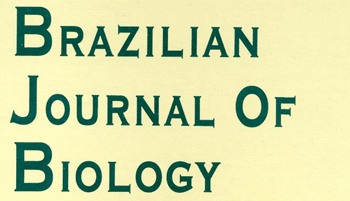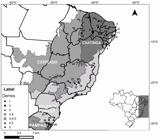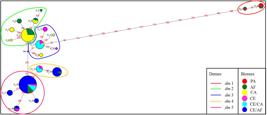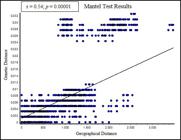Abstract
Didelphis albiventris are found throughout Northeast and Central Brazil to central-southern Uruguay and it was subject of few studies in a population level. Given this, the present study investigated the genetic variability of the species using the mitochondrial molecular marker cytochrome oxidase c subunit I. We analyzed samples from the different biomes within three Brazilian regions: Northeast (Caatinga , Cerrado, and Atlantic Forest), Southeast (Cerrado , Atlantic Forest, Cerrado/Atlantic Forest, and Cerrado/Caatinga ecotones) and South (Pampa and Atlantic Forest). Software BAPs retrieved five distinct demes: dm 1, dm 2, and dm 5 that occurs in South, Northeast and Southeast regions respectively and the dm 3 and dm 4 are wide distributed in Northeast and Southeast. Population analysis performed with AMOVA, haplotype network and Mantel test estimated the veracity of the demes. The FST shows structuring for the five demes, with dm 1 (South region) isolated from the others, however the other analysis showed the Northeast/Southeast demes (dm 2-5) united, diagnosing gene flow between them, mainly at the transitional zones, in areas as far away as areas with similar latitude interval (Southeast vs South) that was not detected gene flow. In the haplotype network, the mutational steps was conclusive in split dm1 from dm 2-5 with 15 mutational steps and the Mantel test was moderated, which is explained by genetic similarity despite the great geographic distances (Northeast/Southeast). Thus, our analysis recognized two different lineages (South and Northeast/Southeast) and indicate that the biomes were not decisive in their isolation. The sharing of demes at the transitional zones and in areas with high latitudinal intervals reflects a recent ancestral polymorphism for D. albiventris. The plasticity in the occupation of the space by this species contributes in its wide dispersion capability, that is, geographical distribution. Our results revealed important implications for the management of D. albiventris in these transitional zones areas where demes were shared.
Keywords:
marsupials; COI; population diversity; geographic lineages

 Thumbnail
Thumbnail
 Thumbnail
Thumbnail
 Thumbnail
Thumbnail
 Thumbnail
Thumbnail



